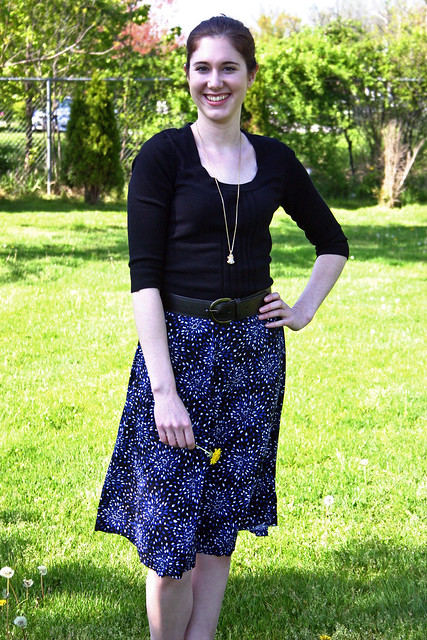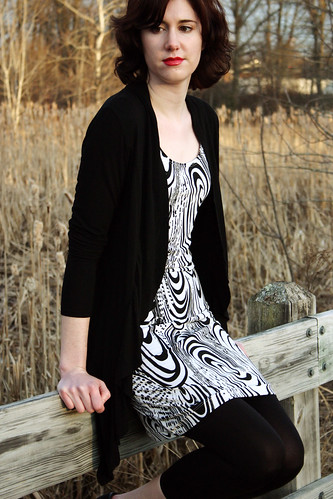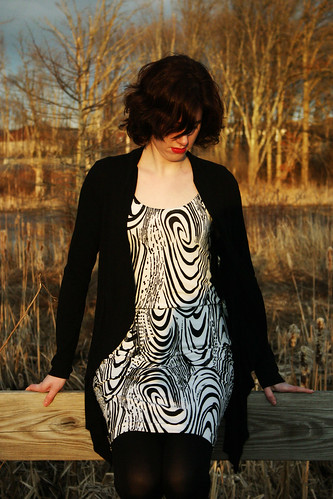Back in May 2010, my sister and now brother-in-law were married. My mother, being the sewer that she is, set out to make a dress for the occasion. She found a beautiful floral print that matched my sister’s color theme, picked out a pattern from her stash, and sewed the dress. She wasn’t quite happy with the first version of it, and when she did some more tweaks here and there to the fit, she still didn’t like it.
I gave my honest feedback to my mom, because who else other than a daughter is going to tell her the truth: the dress didn’t work for her shape. The defined waist of the dress didn’t look good and emphasized what she didn’t want to draw attention to.
In the end, she purchased more of the same floral fabric from Joann Fabrics and completely overhauled the dress to something totally different than the original plan. It turned out quite nicely for the big day.
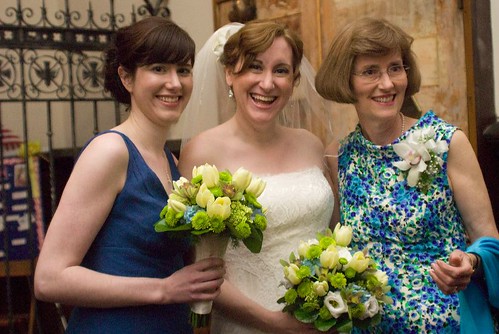 Me, my sister, and my mom
Me, my sister, and my mom
Looking at the back of the Vogue pattern envelope, we noticed the “Figure Flattery” symbols, which point out which body shapes would work for certain patterns. In case you’re not familiar with the concept (from
Vogue Patterns):
Determine your body shape from the explanations below and use our KEY TO FIGURE FLATTERY diagram to select styles that are particularly flattering to your figure. Choosing styles suited to your body shape can also eliminate the need for most pattern adjustments. Look for the figure symbol that indicates your body shape, then proceed with confidence, knowing that your pattern adjustments will be minimal and your finished garment will be pure figure flattery.

THE INVERTED TRIANGLE: Large bust and/or broad shoulders with narrow hips.

THE TRIANGLE: Small bust and/or narrow shoulders with full hips and/or thighs.

THE RECTANGLE: Balanced on top and bottom, but boxy, with little or no waist definition.

THE HOURGLASS: Equally balanced on top and bottom, with a trim waist.
I’m “The Rectangle,” as is my mom – I pretty much don’t have much in the way of “curves” or a defined waist. The pattern my mom was going to originally use? Not recommended for rectangles.
In this instance, “Figure Flattery” was right about the pattern not being the correct style for a rectangle body shape. But what about this dress that I recently made from a Vogue pattern?
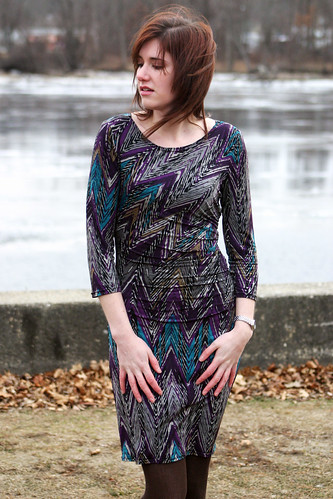
Again, this pattern is not suitable for a rectangle shape according to the envelope. But it turned out just fine and I received lots of compliments about the fit.
Which makes me think – should we be paying attention to “Figure Flattery” when selecting which patterns to sew? I learned about how to dress different body shapes in Home Ec class in high school when we took our measurements to determine if we were “apple,” “pear,” “hourglass,” or “straight,” and then correlated our shape to what kinds of garments and necklines look best on us. “What Not to Wear” and other reality make-over shows on TV educate women on how to dress to look their best. Does Vogue Patterns have it right when stating that a dress will look good only on an hourglass and triangle body but not a rectangle or inverted triangle body?
When I took a look at the new 2012 patterns for spring, I paid attention to those four little icons on the right hand side of my screen. Here’s what I should be sewing:

That illustrates a majority of the patterns in the spring 2012 collection that I should be sewing if going solely on the Figure Flattery guidelines (there were a few patterns that I included previously in
my review that do work for my shape). Notice a shape theme here – or lack thereof, really. Why on earth would I want to dress in a sack? When my mom and I sat down to look at the pattern book and discovered that these were the type of patterns recommended for us to sew, she sighed and said that “sack dresses” were what she used to sew all the time in the 90’s – it was the style then and everyone was wearing them. Now, she wouldn’t go near a dress like that because she doesn’t want to feel like a waist-less, shapeless blob. And those are exactly the options that Vogue is giving us, if we were to follow their recommendations.
I know what kind of shapes generally work for me: a-line skirts, pencil skirts, flared dresses, wide belts, fluffy blouses. I rarely see these types of patterns recommended for rectangles. Sure, it’s easy to fit a rectangular shaped pattern to a rectangle body, but does it flatter, as their term implies?
I’m not knocking their recommendations entirely, though. For example, I know that this dress would not work for me at all. I don’t have the boobs to fill it out and it’s pretty tight:
The same goes with this dress. I’ve made dresses with a waistline seam like this one before and it just doesn’t work at all:
I know that there will be some that are reading this thinking that I shouldn’t be complaining about finding patterns to sew that will fit me and look fine. Everyone has some type of fitting problem when it comes to sewing, though, and my problems are that I can’t fill out most dresses and blouses since I have a high, small bust, I have narrow shoulders, no waist, and my hips are slightly larger than my chest so I need to grade out my patterns. No one is perfect.
I guess what it comes down to is knowing what works for your body type and sewing what makes you happy – Figure Flattery is just a guideline. My sewing is based on patterns that are suited for my sewing ability, will be easy to fit, and look stylish. But I always have that little voice in the back of my head when I look at Vogue Patterns that says to me, “are you sure this will work for you? There’s no rectangle icon for this pattern.”
Does Figure Flattery work for you or do you ignore it?
